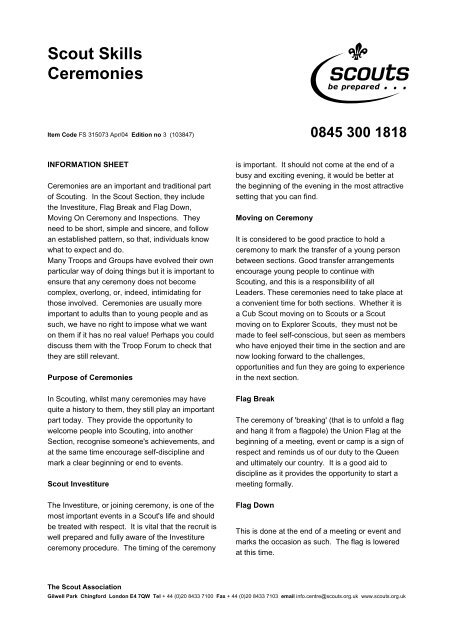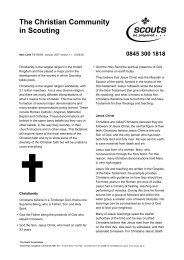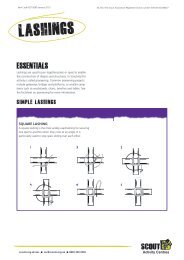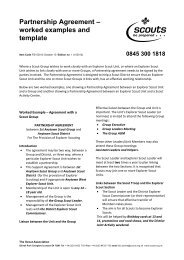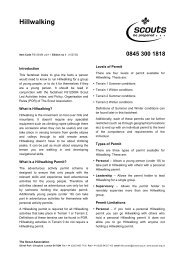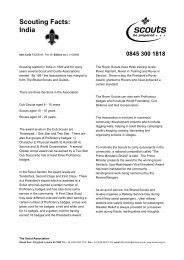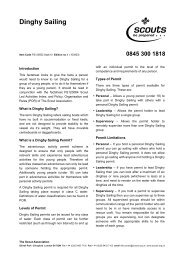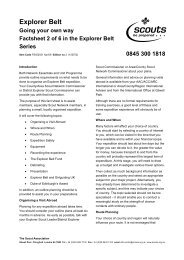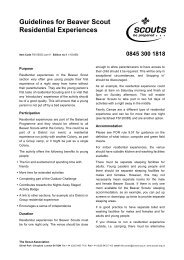FS315073 - Scout Skills - Ceremonies - ScoutBase UK
FS315073 - Scout Skills - Ceremonies - ScoutBase UK
FS315073 - Scout Skills - Ceremonies - ScoutBase UK
You also want an ePaper? Increase the reach of your titles
YUMPU automatically turns print PDFs into web optimized ePapers that Google loves.
<strong>Scout</strong> <strong>Skills</strong><strong>Ceremonies</strong>SItem Code FS 315073 Apr/04 Edition no 3 (103847) 0845 300 1818INFORMATION SHEET<strong>Ceremonies</strong> are an important and traditional partof <strong>Scout</strong>ing. In the <strong>Scout</strong> Section, they includethe Investiture, Flag Break and Flag Down,Moving On Ceremony and Inspections. Theyneed to be short, simple and sincere, and followan established pattern, so that, individuals knowwhat to expect and do.Many Troops and Groups have evolved their ownparticular way of doing things but it is important toensure that any ceremony does not becomecomplex, overlong, or, indeed, intimidating forthose involved. <strong>Ceremonies</strong> are usually moreimportant to adults than to young people and assuch, we have no right to impose what we wanton them if it has no real value! Perhaps you coulddiscuss them with the Troop Forum to check thatthey are still relevant.Purpose of <strong>Ceremonies</strong>In <strong>Scout</strong>ing, whilst many ceremonies may havequite a history to them, they still play an importantpart today. They provide the opportunity towelcome people into <strong>Scout</strong>ing, into anotherSection, recognise someone's achievements, andat the same time encourage self-discipline andmark a clear beginning or end to events.<strong>Scout</strong> InvestitureThe Investiture, or joining ceremony, is one of themost important events in a <strong>Scout</strong>'s life and shouldbe treated with respect. It is vital that the recruit iswell prepared and fully aware of the Investitureceremony procedure. The timing of the ceremonyis important. It should not come at the end of abusy and exciting evening, it would be better atthe beginning of the evening in the most attractivesetting that you can find.Moving on CeremonyIt is considered to be good practice to hold aceremony to mark the transfer of a young personbetween sections. Good transfer arrangementsencourage young people to continue with<strong>Scout</strong>ing, and this is a responsibility of allLeaders. These ceremonies need to take place ata convenient time for both sections. Whether it isa Cub <strong>Scout</strong> moving on to <strong>Scout</strong>s or a <strong>Scout</strong>moving on to Explorer <strong>Scout</strong>s, they must not bemade to feel self-conscious, but seen as memberswho have enjoyed their time in the section and arenow looking forward to the challenges,opportunities and fun they are going to experiencein the next section.Flag BreakThe ceremony of 'breaking' (that is to unfold a flagand hang it from a flagpole) the Union Flag at thebeginning of a meeting, event or camp is a sign ofrespect and reminds us of our duty to the Queenand ultimately our country. It is a good aid todiscipline as it provides the opportunity to start ameeting formally.Flag DownThis is done at the end of a meeting or event andmarks the occasion as such. The flag is loweredat this time.The <strong>Scout</strong> AssociationGilwell Park Chingford London E4 7QW Tel + 44 (0)20 8433 7100 Fax + 44 (0)20 8433 7103 email info.centre@scouts.org.uk www.scouts.org.uk
page 2 of 7A prayer or an opportunity for quiet reflection maybe used either at the beginning or end of ameeting.InspectionsThese are one way of encouraging a highstandard at meetings and at camp. They are alsoabout encouraging young people to takeresponsibility for themselves. They should beshort, friendly and helpful. <strong>Scout</strong>s should beaware that they might be inspected onattendance, uniform, general smartness, personalcleanliness and on certain occasions, onindividual items, such as handkerchiefs. Adversecomments should be constructive and given in afriendly manner, not as a negative criticism whichmay be resented.It may well be that the Troop wishes to introduce acompetitive edge and encourage <strong>Scout</strong>s to dotheir best, by giving points for inspection. It isvery important that these are allocated on a fairsystem and if it is part of an inter-Patrolcompetition, the system needs to be monitored toensure that it doesn't become all-important. It iswhat underlies inspection that is important, notwhether one <strong>Scout</strong> is essentially cleaner and tidierthan another.Further information and resourcesChapter 3 of Troop Essentials “Organising the<strong>Scout</strong> Troop” outlines the details of ceremoniesand other aspects such as Badge, Award or otherpresentations.Speak with experienced <strong>Scout</strong> Leaders about theceremonies undertaken in your Troop and otherTroops in the District. They may have some hintsand tips which will help you.TEACH YOURSELF<strong>Ceremonies</strong> have an important and traditionalplace in the <strong>Scout</strong> Troop and there may be someslight variations in how these are performed fromTroop to Troop. The essential factors are thatthey are short, simple and sincere. Simple so thateveryone can understand what is going on; shortbecause if it is too long, <strong>Scout</strong>s become boredand fidget; sincere because unless takenseriously and the <strong>Scout</strong>s appreciate their value,there is no point in having them.TimeThis is variable because some ceremonies, likeFlag Break, are relatively simple and usedregularly in the Troop. Others, like Investituresare a little more complicated and not used asoften. However, an hour would allow you tobecome familiar with the basic principles.EquipmentTroop, National and Union flags.Learning all about itBefore having a go, you will need to read theInformation Sheet section at the start of thisfactsheet if you have not already done so.Being proficient and responsible for ceremonies inthe Troop comes with practice and experience,and unfortunately it is difficult to practise as suchand set up false situations in which to teachyourself. It may be a case of watching or'shadowing' experienced Leaders during variousceremonies and perhaps taking the opportunitybefore or after a Troop meeting or a quiet momentat camp, to practise a few aspects.It is worthwhile taking time for the properpreparation for all ceremonies since atmosphereand 'stage management' are important to theoverall effectiveness. Everyone who is taking partshould know what to do and when to do it.Wherever and whenever possible ceremoniesshould be conducted outdoors.<strong>Scout</strong> InvestitureThis is the most important <strong>Scout</strong> ceremony and isone that should be treated with dignity andrespect. All of your <strong>Scout</strong>s need to be aware that
page 3 of 7you expect this from them. You will probably befeeling apprehensive before you conduct your firstInvestiture, but remember that the new <strong>Scout</strong> isprobably feeling even more nervous! It needs tobe a memorable experience for the <strong>Scout</strong> so trydifferent opportunities for instance dawn during awinter camp.The main thing to remember is to ensureadequate preparation and briefing of the <strong>Scout</strong>,any Assistants and other Leaders present, andnot forgetting yourself. It may be useful to carry asmall card with the <strong>Scout</strong> Law and Promise on, incase of any hiccups in the middle of theceremony. It may also be attended by parents orparticular friends of the <strong>Scout</strong>, and for that reason,should be well planned in advance.The Investiture may vary slightly from Troop toTroop but here are the basic steps: Sometime before the ceremony, the Leaderwill chat with the <strong>Scout</strong> and discuss themeaning of the Promise and Law and help the<strong>Scout</strong> to understand what is meant by'honour'. The ceremony itself should also beexplained so that it does not come as acomplete surprise! Immediately before, the Leader takes theopportunity to remind the rest of the Troopwhat will happen in order to set the scene.They may need to be reminded what it felt likewhen they became <strong>Scout</strong>s! The <strong>Scout</strong>s then stand in a horseshoe withthe <strong>Scout</strong> Leader in the mouth of thehorseshoe. Any Assistant <strong>Scout</strong> Leadersstand to the right of the <strong>Scout</strong> Leader and alittle to the rear. A <strong>Scout</strong> stands holding theflag between the <strong>Scout</strong> Leader and theirAssistants. The <strong>Scout</strong> Leader or an Assistantthen calls the Troop to the alert. The new <strong>Scout</strong> moves forward and faces the<strong>Scout</strong> Leader. If the Troop operates with aPatrol system it may be that the Patrol Leaderbrings the new <strong>Scout</strong> forward. The PatrolLeader then takes one pace backward. The <strong>Scout</strong> Leader then asks the new <strong>Scout</strong> ifhe or she understands what is meant byhonour and the importance of the Promiseand Law.If the answer to this is 'yes', a <strong>Scout</strong> holdingthe flag, lowers it so that it is waist highbetween the <strong>Scout</strong> Leader and the new <strong>Scout</strong>who both place their left hands on the flag andmake the <strong>Scout</strong> Sign with their right hands.At this time, the Troop and any other personin the room, who has made their Promise, isasked to make the <strong>Scout</strong> Sign and the new<strong>Scout</strong> then repeats the Promise after the<strong>Scout</strong> Leader. (It is usual for the <strong>Scout</strong> Leaderto say the Promise line by line with the new<strong>Scout</strong> repeating it afterwards as it can be adaunting time without having to worry aboutforgetting the words.)After the Promise has been said, everyonedrops their hands from the <strong>Scout</strong> Sign and theflag bearer lifts the flag.The <strong>Scout</strong> Leader then presents the badgesand may shake hands. If the <strong>Scout</strong> iscompletely new to the Movement, the <strong>Scout</strong>Leader should also present the Group scarfand welcome the new Member to theworldwide family of <strong>Scout</strong>ing. (If the Group<strong>Scout</strong> Leader is present, they may wish to dothis).If a Patrol Leader has accompanied the new<strong>Scout</strong> they may give the Patrol Badge to the<strong>Scout</strong> to show that he or she is a member ofthat Patrol.The <strong>Scout</strong> Leader salutes the new <strong>Scout</strong> whoreturns the salute. The new <strong>Scout</strong> then turnsto face the Troop, salutes and the Troopreturns the salute.The new <strong>Scout</strong> then goes (with the PatrolLeader) to join the Patrol.See diagram below for Investiture Ceremony
page 4 of 7with the <strong>Scout</strong> handshake and a fewwords.If the Cub <strong>Scout</strong>s have already completedthe requirements for the <strong>Scout</strong>Membership Award they could also beinvested. Alternatively, it may beappropriate to invest them at the nextTroop meeting.New <strong>Scout</strong><strong>Scout</strong><strong>Scout</strong>Moving On CeremonyThe Moving-On Ceremony from Cub <strong>Scout</strong>s to<strong>Scout</strong>sThe Cub <strong>Scout</strong> Leader and the <strong>Scout</strong> Leaderneed to agree and organise a suitable place andtime for this to happen, this may be at the end of apack meeting if the troop meeting follows on. It ispreferable for more than one Cub <strong>Scout</strong> totransfer at any one time. The parents/carers of theCub <strong>Scout</strong>s who are transferring to the Troopshould have been invited.The Moving-On-Award may be presented by theCub <strong>Scout</strong> Leader or the Group <strong>Scout</strong> Leader.Here are some steps to a standard approachThe Pack and Troop assemble in an opencircle.A Leader calls the Group to the alert andbriefly explains the purpose of theceremony.The young people that are transferringshould then be presented with theirMoving-on-Award.They move into the centre of the circleand receive a fond farewell from the Cub<strong>Scout</strong> Leader.The <strong>Scout</strong> Leader and the Patrol Leaderthen welcome them to the <strong>Scout</strong> TroopThe Moving-On Ceremony from <strong>Scout</strong>s toExplorer <strong>Scout</strong>sThe <strong>Scout</strong> Leader and the Explorer <strong>Scout</strong> Leaderneed to agree and organise a suitable place andtime for this to happen. This may be at a Troopmeeting or other Group event.The Moving-On-Award may be presented by the<strong>Scout</strong> Leader or Group <strong>Scout</strong> Leader.Things to consider when planning the CeremonySome of the Explorer <strong>Scout</strong>s in theDistrict and the parents/carers of the<strong>Scout</strong>s who are transferring to the Unitmay have been invited.When wishing the <strong>Scout</strong> good luck youmay want to talk about the achievementsof the individual during their time in theTroop (taking care not to causeembarrassment).
page 5 of 7The presentation should be made whenand where the young person is happy tohave it made. Some examples of suchplaces include: On the summit of a localhill, at the bottom of the local swimmingpool, during a night activity, as part of areligious ceremony.Flag Break and Flag DownThese are part of most Troop meetings and youwill find it valuable to have practised folding andhoisting the flag and breaking it, so that noembarrassing situations arise on Troop night.This is something that you can practise wheneveryone else has gone home!Here are the steps to be taken: Fold, prepare and hoist the flag.The Troop members are asked to fall in andform a horseshoe facing the flag and standingat ease (any Leaders present stand on eitherside of the flag-pole).The Troop is brought to the alert and all thosenot directly facing the flag (the Leaders forexample) should do so at this point.A <strong>Scout</strong> (briefed beforehand) walks up to theflag and pulls on the halliard or 'breaking' ropeto 'break' or let the flag unfold.Once it has unfolded, the Troop salutes intime with the <strong>Scout</strong>.The <strong>Scout</strong> then returns to his or her Patroland the Troop is stood 'at ease'.Notices or information are often given out at thispoint before the Troop is brought back to the alertand then instructed to fall out that is, move awayfrom the horseshoe.Flag down ceremony is undertaken in a similarway: The Troop is assembled again in thehorseshoe shape and brought to the 'alert'. The <strong>Scout</strong> walks to the flag, unties the ropeholding it in position and lowers the flagslowly, ensuring that it does not touch theground, which is considered disrespectful. The <strong>Scout</strong> then stands back, still facing theflag, and at the alert for a few seconds. Nosalute is given at this time. He or she thenreturns to their Patrol before the Troop isdismissed. The flag may then be folded and prepared forthe next time. This will depend upon eachTroop's own situation.At camp, the procedure is much the same withFlag break at the start of the day being carried outin the same manner as for an indoor meeting. It isquite appropriate for everyone to be dressed incamp kit at this time rather than have to changeinto uniform.For Flag down, which should be at a fixed timebefore sunset, two pre selected <strong>Scout</strong>s go to theflagpole. A long blast on a whistle or ring of a bellis given and everyone stops where they are, whatthey are doing, and stands to attention and facesthe flag. The flag is then lowered. Then anothersignal, such as two short blasts on the whistle, isgiven as the signal to 'carry on'. The <strong>Scout</strong>s thenattend to the flag by folding it and preparing it forthe next day.Although Flag break and Flag down are notnormally undertaken by a Leader, it is obviouslyimportant that he or she knows what happens andhow to help if something goes wrong!InspectionsInspections may be used at Troop meetings or atcamp. Inspections on a Troop night tend to beabout a <strong>Scout</strong>'s personal appearance whereas atcamp, an inspection is based on more practicalaspects of the camp itself.
page 6 of 7You must decide what is going to be included inyour Troop inspection and ensure that the <strong>Scout</strong>sknow as well. It might include; smartness,personal cleanliness, correct uniform and so on.This, of course will mean you will need to beaware of correct uniform and the placing ofbadges.At camp, you might be looking at the tidiness ofpersonal kit, sleeping gear, tents, Patrol areas andso on.Once you have worked out what you are lookingfor, you should also consider what the standardsshould be. Again, you should inform the <strong>Scout</strong>s ofwhat they are. They will not gain anything fromInspections if they do not know what they aresupposed to achieve.It is also important to think about how you mightsupportively help a <strong>Scout</strong> to improve standards.Inspections have to be constructive; offersuggestions of how to improve, and encouragethe <strong>Scout</strong> to consider ways in which they mighthelp themselves. This should include a time limitby when something will be re-checked.Here are some steps that might be considered:List the areas that are to be inspected (suchas uniform, cleanliness and so on). Considerthe standards that are/are not acceptable.Inform the <strong>Scout</strong>s of these standards.Consider constructive ways in which to helpthe <strong>Scout</strong>s improve.Implement any points system or competitionthat you said you would!Can you do it?When you feel confident about ceremonies, seehow many of these questions you can answer: Can I state the purpose for, and describe thefollowing ceremonies?The Investiture Moving-On Ceremony Flag breakFlag downHave I observed and assisted at anotherTroop's ceremonies as listed above? Have I been responsible for the followingwithin the Troop meeting?InvestitureMoving-on Ceremony Flag breakFlag downInspectionsSometimes it is useful to have a more experiencedLeader in the Section, perhaps theAssistant District Commissioner (<strong>Scout</strong>s) to comeand give you an unbiased view of the ceremonieswithin your Troop and, if possible, how they canbe improved upon. The final word is that 'practicemakes perfect' and with these ceremonies that arehappening constantly throughout Troop life, aLeader is sure to become more experienced andconfident.HOW TO TRAIN OTHERSThis section is designed to give you somepractical ideas about how you can help otherpeople to learn about ceremonies in the Troop.This might be Leaders or <strong>Scout</strong>s either in aninformal way on a Troop night or more formally ona skills workshop, training course or somethingsimilar.ObjectivesBy the end of this session, the participants will beable to:I. State the reason for ceremonies in the Troop;II. Demonstrate the following ceremonies:III. InvestitureIV. Moving-on ceremonyV. Flag break and Flag downVI. State the purpose and methods of inspectionin the Troop.TimeAbout two hours should be allowed to learn theceremonies described, but confidence will onlycome with familiarity and experience.
page 7 of 7EquipmentTroop, National and Union flags.Training methodThere are very few methods that can be used tolearn about ceremonies - undertaking theceremonies themselves or watching them is themost valuable. However, if this is not possible,the subject can be introduced by a discussion ofthe participants’ experiences of variousceremonies both good and bad. The sessionleader should help participants identify why thesehappened so that these experiences should, orshouldn't happen again! This could then befollowed by some discussion about the purposeand value of ceremonies in the <strong>Scout</strong> Troop.So they want to know more? Suggest that they visit another Troop to see ifthere are any variations to the methods used. Contact current or ex-military personnel whomay be able to help with such topics ascommands and carrying and presentingcolours and flags.The actual ceremonies showing correct andincorrect methods, could be demonstrated bysome participants, with the session leaderbriefing them in front of the others. Following this,participants, in small groups, could have a go atrole-playing different ceremonies. Care must betaken not to 'make fun' of the ceremonies withinthe role play and it will be useful to allow eachparticipant to have a go at all the main roles. Foryoung people, it is probably only appropriate forthem to practise Flag break and Flag down.Checking their progressAsk participants if they can answer the followingquestions:Do I know the reason for having the followingceremonies in the Troop?The InvestitureMoving-on ceremonyFlag break and Flag downInspections Can I undertake the following ceremonies?The InvestitureMoving-on ceremonyFlag break and Flag down Inspections


